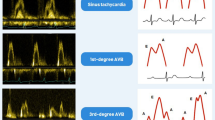Abstract
The double-root translocation (DRT) procedure is considered as a new choice for surgical management of complex congenital heart disease. Our study aims to investigate the left ventricular hemodynamic status after DRT by energy loss (EL), involving 42 patients who underwent DRT as well as 42 healthy volunteers as controls. The EL of left ventricle (LV) during different periods (rapid filling-RF, atrial contraction-AC, isovolumic contraction-IVC, rapid ejection-RE) of the same cardiac cycle were obtained and analyzed. Compared to the controls, global LV and apical three chamber-EL at AC and IVC periods in DRT group were higher (p < 0.05), and EL at RE period of DRT group was moderately lower. In the correlation analysis, the global EL at the RF was correlated with E wave (r = 0.47, p = 0.03), E/e′ (r = 0.50, p = 0.02), BSA (r = − 0.54, p = 0.01), and age (r = − 0.67, p < 0.001). AC and RE- global EL were significantly correlated with E/e′ (r = 0.49, r = 0.59, p < 0.05). There was a strong positive correlation between E/e′ and global EL at the IVC (r = 0.62, p = 0.003) and a moderate negative correlation with age (r = − 0.44, p = 0.04). The present study confirms that EL is a feasible and reproducible indicator for quantitatively evaluating LV hemodynamic status in patients who underwent DRT and reveals that DRT can lead to approximatively normal long-term hemodynamic performance of LV.



Similar content being viewed by others
References
Rastelli GC, McGoon DC, Wallace RB (1969) Anatomic correction of transposition of the great arteries with ventricular septal defect and subpulmonary stenosis. J Thorac Cardiovasc Surg 58:545–552
Lecompte Y, Neveux JY, Leca F et al (1982) Reconstruction of the pulmonary outflow tract without prosthetic conduit. J Thorac Cardiovasc Surg 84:727–733
Hu SS, Liu ZG, Li SJ et al (2008) Strategy for biventricular outflow tract reconstruction: Rastelli, REV, or Nikaidoh procedure? J Thorac Cardiovasc Surg 135:331–338. https://doi.org/10.1016/j.jtcvs.2007.09.060
Hu S, Xie Y, Li S et al (2010) Double-root translocation for doubleoutlet right ventricle with noncommitted ventricular septal defect or double-outlet right ventricle with subpulmonary ventricular septal defect associated with pulmonary stenosis: an optimized solution. Ann Thorac Surg 89:1360–1365. https://doi.org/10.1016/j.athoracsur.2010.02.007
Hayashi T, Itatani K, Inuzuka R et al (2015) Dissipative energy loss within the left ventricle detected by vector flow mapping in children: normal values and effects of age and heart rate. J Cardiol 66:403–410. https://doi.org/10.1016/j.jjcc.2014.12.012
Leischik R, Littwitz H, Dworrak B et al (2015) Echocardiographic evaluation of left atrial mechanics: function, history, novel techniques, advantages, and pitfalls. Biomed Res Int 2015:1–12. https://doi.org/10.1155/2015/765921
Uejima T, Koike A, Sawada H et al (2010) A new echocardiographic method for identifying vortex flow in the left ventricle: numerical validation. Ultrasound Med Biol 36:772–788. https://doi.org/10.1016/j.ultrasmedbio.2010.02.017
Akiyama K, Maeda S, Matsuyama T et al (2017) Vector flow mapping analysis of left ventricular energetic performance in healthy adult volunteers. BMC Cardiovasc Disord 17:21. https://doi.org/10.1186/s12872-016-0444-7
Zhong Y, Liu YT, Wu T et al (2016) Assessment of left ventricular dissipative energy loss by vector flow mapping in patients with end-stage renal disease. J Ultrasound Med 35:965–973. https://doi.org/10.7863/ultra.15.06009
Li CM, Bai WJ, Liu YT, Tang H, Rao L (2017) Dissipative energy loss within the left ventricle detected by vector flow mapping in diabetic patients with controlled and uncontrolled blood glucose levels. Int J Cardiovasc Imaging 33:1151–1158. https://doi.org/10.1007/s10554-017-1100-8
Bahlmann E, Gerdts E, Cramariuc D et al (2013) Prognostic value of energy loss index in asymptomatic aortic stenosis. Circulation 127:1149–1156. https://doi.org/10.1161/CIRCULATIONAHA.112.078857
Stugaard M, Koriyama H, Katsuki K et al (2015) Energy loss in the left ventricle obtained by vector flow mapping as a new quantitative measure of severity of aortic regurgitation: a combined experimental and clinical study. Eur Heart J Cardiovasc Imaging 16:723–730. https://doi.org/10.1093/ehjci/jev035
Lang RM, Badano LP, Mor-Avi V et al (2015) Recommendations for cardiac chamber quantification by echocardiography in adults: an update from the American Society of Echocardiography and the European Association of Cardiovascular Imaging. J Am Soc Echocardiogr 28(1):1–39. https://doi.org/10.1093/ehjci/jew041
Itatani K, Okada T, Uejima T et al (2013) Intraventricular flow velocity vector visualization based on the continuity equation and measurements of vorticity and wall shear stress. Jpn J Appl Phys 52:07–16. https://doi.org/10.7567/JJAP.52.07HF16
Loerakker S, Cox L, van Heijst G et al (2008) Influence of dilated cardiomyopathy and a left ventricular assist device on vortex dynamics in the left ventricle. Comput Methods Biomech Biomed Eng 11(6):649–660
Acknowledgements
The authors thank Dr. Yiran Hu ( Fuwai Hospital, Beijing, China) for his assistance of echocardiographic data analysis.
Funding
None.
Author information
Authors and Affiliations
Contributions
HL involved in design and drafting article. QLM and YHF performed data collection and data analysis. RL did critical revision of article. SHH and KJP participated in approval of the article.
Corresponding author
Ethics declarations
Conflict of interest
The authors declare that they have no conflicts of interest with respect to this manuscript.
Informed Consent
Informed consent was obtained from all individual participants included in this study.
Additional information
Publisher's Note
Springer Nature remains neutral with regard to jurisdictional claims in published maps and institutional affiliations.
Rights and permissions
About this article
Cite this article
Li, H., Hu, S., Meng, Q. et al. Evaluation of the Left Ventricular Hemodynamic Status of Double-Root Translocation Patients Through Vector Flow Mapping. Pediatr Cardiol 41, 1466–1472 (2020). https://doi.org/10.1007/s00246-020-02407-x
Received:
Accepted:
Published:
Issue Date:
DOI: https://doi.org/10.1007/s00246-020-02407-x




